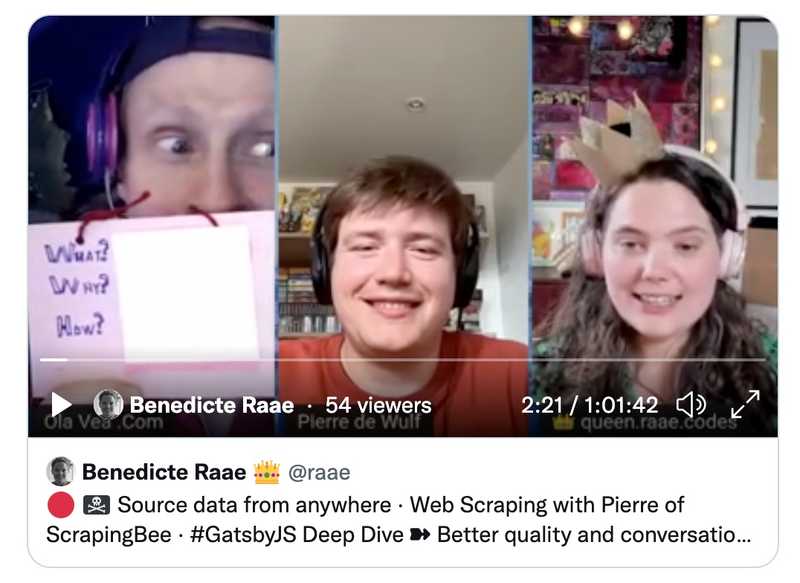Source content from anywhere with ScrapingBee
Pierre de Wulf, co-founder of ScrapingBee joined us on yesterday's unauthorized and rum-fueled treasure hunt in the sharky waters around the Gatsby islands.
The What?
Source Crowdcast webinars into the Gatsby Data Layer using ScrapingBee — an API that simplifies web scraping.
The Why?
There is no official Crowdcast API and keeping the data in sync using copy/past is a pain (or at least boring 🤪). To scrape from Crowdcast, we need to load the page in a headless browser such as Puppeteer. Doing so is not possible as part of the Gatsby build process, so we outsource it to ScrapingBee.
The How
We used the Data Extraction-feature from ScrapingBee. It lets us select data on a page using CSS-selector. It felt kinda similar to cheerio if you have ever used that.
As always, I started with copy/pasting the example snippets. It worked almost out of the box, but we had to make use of the wait_for option as the Crowdcast page takes a while to load:
It's sometimes necessary to wait for a particular element to appear in the DOM before ScrapingBee returns the HTML content. ScrapingBee Docs
The Code
const axios = require("axios");
const scrapeCrowdcast = async () => {
const { data } = await axios.get("https://app.scrapingbee.com/api/v1", {
params: {
api_key: process.env.SCRAPING_BEE_API_KEY,
url: "https://www.crowdcast.io/raae",
// Wait for there to be at least one
// non-empty .event-tile element
wait_for: ".event-tile",
extract_rules: {
webinars: {
// Lets create a list with data
// extracted from the .event-tile element
selector: ".event-tile",
type: "list",
// Each object in the list should
output: {
// have a title lifted from
// the .event-tile__title element
title: ".event-tile__title",
// and a path lifted from
// the href attribute of the first link element
path: {
selector: "a",
output: "@href",
},
},
},
},
},
});
return data;
};The resulting data object:
{
webinars: [
{
title: "5 Gatsby Gotchas to look out for as a React developer",
path: "/e/gatsby-gotchas-react?utm_source=profile&utm_medium=profile_web&utm_campaign=profile",
},
{
title: "Testing your Gatsby Serverless Functions",
path: "/e/testing-your-functions?utm_source=profile&utm_medium=profile_web&utm_campaign=profile",
},
// and more
];
}We then loop through the webinars on the data object creating content nodes:
// gatsby-node.js
exports.sourceNodes = async (gatsbyUtils) => {
const { actions, createNodeId, createContentDigest } = gatsbyUtils;
const { createNode } = actions;
const data = await scrapeCrowdcast();
for (const webinar of data.webinars) {
createNode({
id: createNodeId(webinar.path),
title: webinar.title,
url: "https://www.crowdcast.io" + webinar.path,
rawScrape: webinar,
internal: {
type: `CrowdcastWebinar`,
mediaType: `text/json`,
content: JSON.stringify(webinar),
contentDigest: createContentDigest(webinar),
},
});
}
};And voila, we have webinar nodes in our data layer:
query MyQuery {
allCrowdcastWebinar {
nodes {
title
url
}
}
}To see the entire demo, check out its GitHub repository.
Should we make this a full-featured plugin? Extracting the cover art and descriptions from the individual webinar pages? Let me know!
All the best,
Queen Raae
PS: ScrapingBee is a paid service, but we are as always neither sponsored nor an affiliate.
PPS: If you want to learn more about web-scraping without ScrapingBee check out their article Web Scraping with Javascript and NodeJS.
